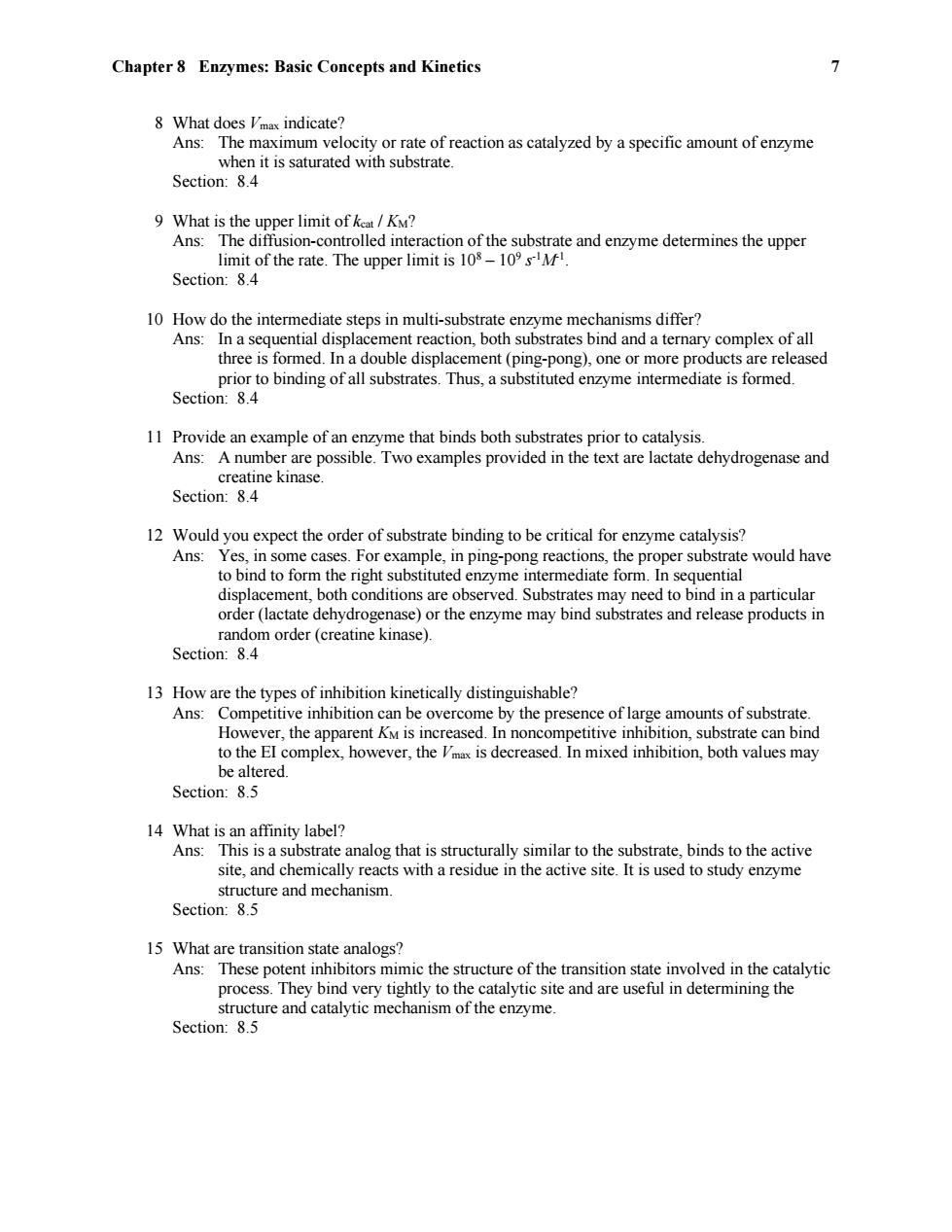正在加载图片...

Chapter 8 Enzymes:Basic Concepts and Kinetics 7 8 What does Imax indicate? Ans:The maximum velocity or rate of reaction as catalyzed by a specific amount of enzyme when it is saturated with substrate. Section:8.4 9 What is the upper limit of keat KM? Ans:The diffusion-controlled interaction of the substrate and enzyme determines the upper limit of the rate.The upper limit is 108-10%sM. Section:8.4 10 How do the intermediate steps in multi-substrate enzyme mechanisms differ? Ans:In a sequential displacement reaction,both substrates bind and a ternary complex of all three is formed.In a double displacement(ping-pong),one or more products are released prior to binding of all substrates.Thus,a substituted enzyme intermediate is formed. Section:8.4 11 Provide an example of an enzyme that binds both substrates prior to catalysis. Ans:A number are possible.Two examples provided in the text are lactate dehydrogenase and creatine kinase. Section:8.4 12 Would you expect the order of substrate binding to be critical for enzyme catalysis? Ans:Yes,in some cases.For example,in ping-pong reactions,the proper substrate would have to bind to form the right substituted enzyme intermediate form.In sequential displacement,both conditions are observed.Substrates may need to bind in a particular order(lactate dehydrogenase)or the enzyme may bind substrates and release products in random order (creatine kinase). Section:8.4 13 How are the types of inhibition kinetically distinguishable? Ans:Competitive inhibition can be overcome by the presence of large amounts of substrate. However,the apparent KM is increased.In noncompetitive inhibition,substrate can bind to the EI complex,however,the Vmax is decreased.In mixed inhibition,both values may be altered. Section:8.5 14 What is an affinity label? Ans:This is a substrate analog that is structurally similar to the substrate,binds to the active site,and chemically reacts with a residue in the active site.It is used to study enzyme structure and mechanism. Section:8.5 15 What are transition state analogs? Ans:These potent inhibitors mimic the structure of the transition state involved in the catalytic process.They bind very tightly to the catalytic site and are useful in determining the structure and catalytic mechanism of the enzyme. Section:8.5Chapter 8 Enzymes: Basic Concepts and Kinetics 7 8 What does Vmax indicate? Ans: The maximum velocity or rate of reaction as catalyzed by a specific amount of enzyme when it is saturated with substrate. Section: 8.4 9 What is the upper limit of kcat / KM? Ans: The diffusion-controlled interaction of the substrate and enzyme determines the upper limit of the rate. The upper limit is 10 8 – 10 9 s -1M-1 . Section: 8.4 10 How do the intermediate steps in multi-substrate enzyme mechanisms differ? Ans: In a sequential displacement reaction, both substrates bind and a ternary complex of all three is formed. In a double displacement (ping-pong), one or more products are released prior to binding of all substrates. Thus, a substituted enzyme intermediate is formed. Section: 8.4 11 Provide an example of an enzyme that binds both substrates prior to catalysis. Ans: A number are possible. Two examples provided in the text are lactate dehydrogenase and creatine kinase. Section: 8.4 12 Would you expect the order of substrate binding to be critical for enzyme catalysis? Ans: Yes, in some cases. For example, in ping-pong reactions, the proper substrate would have to bind to form the right substituted enzyme intermediate form. In sequential displacement, both conditions are observed. Substrates may need to bind in a particular order (lactate dehydrogenase) or the enzyme may bind substrates and release products in random order (creatine kinase). Section: 8.4 13 How are the types of inhibition kinetically distinguishable? Ans: Competitive inhibition can be overcome by the presence of large amounts of substrate. However, the apparent KM is increased. In noncompetitive inhibition, substrate can bind to the EI complex, however, the Vmax is decreased. In mixed inhibition, both values may be altered. Section: 8.5 14 What is an affinity label? Ans: This is a substrate analog that is structurally similar to the substrate, binds to the active site, and chemically reacts with a residue in the active site. It is used to study enzyme structure and mechanism. Section: 8.5 15 What are transition state analogs? Ans: These potent inhibitors mimic the structure of the transition state involved in the catalytic process. They bind very tightly to the catalytic site and are useful in determining the structure and catalytic mechanism of the enzyme. Section: 8.5